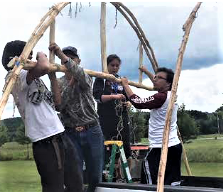The U.S. Department of Agriculture’s Natural Resources Conservation Service, in partnership with the Wisconsin Tribal Conservation Advisory Council (WTCAC), announced a new collaborative publication, Wisconsin Tribal Conservation: Stewardship for the Future, is available online. It highlights successful conservation efforts with the 11 federally recognized Tribes of Wisconsin. Six other USDA agencies and the Wisconsin Department of Agriculture, Trade and Consumer Protection are also partnering to highlight the protection and restoration of natural resources on Wisconsin Tribal lands.
American Indians and Alaska Natives are eligible to participate in all NRCS programs. The NRCS provides technical assistance and financial assistance to private landowners and operators, tribes and tribal members to assist them in protecting and improving natural resources such as soil, water, air, plants, and animals.
Wisconsin Tribal Conservation Advisory Council
 The WTCAC was organized in March 2001 to identify tribal conservation issues and to advise the USDA Natural Resources Conservation Service on more effective ways to deliver USDA programs and assist the Indian Nations of Wisconsin. Tina L. Van Zile is the president of WTCAC.
The WTCAC was organized in March 2001 to identify tribal conservation issues and to advise the USDA Natural Resources Conservation Service on more effective ways to deliver USDA programs and assist the Indian Nations of Wisconsin. Tina L. Van Zile is the president of WTCAC.

Read Tina’s story at Sokaogon Chippewa Community: Mole Lake Band of Lake Superior Chippewa, page 2 and 17. Read about the youth, blending traditional indigenous knowledge with a modern agricultural practice that built a hoop house. (Hoop houses are collapsible greenhouses that can be used to extend the growing of a 300 black spruce seeds.) Since the project’s inception, the Mole Lake Tribe has planted over 1,500 cedar, tamarack, black spruce and balsam fir trees on the wetland restoration on the Mole Lake Reservation, located in the Town of Nashville, in Forest County.
Tina also is a member of the of Board of Directors of WCHF.
